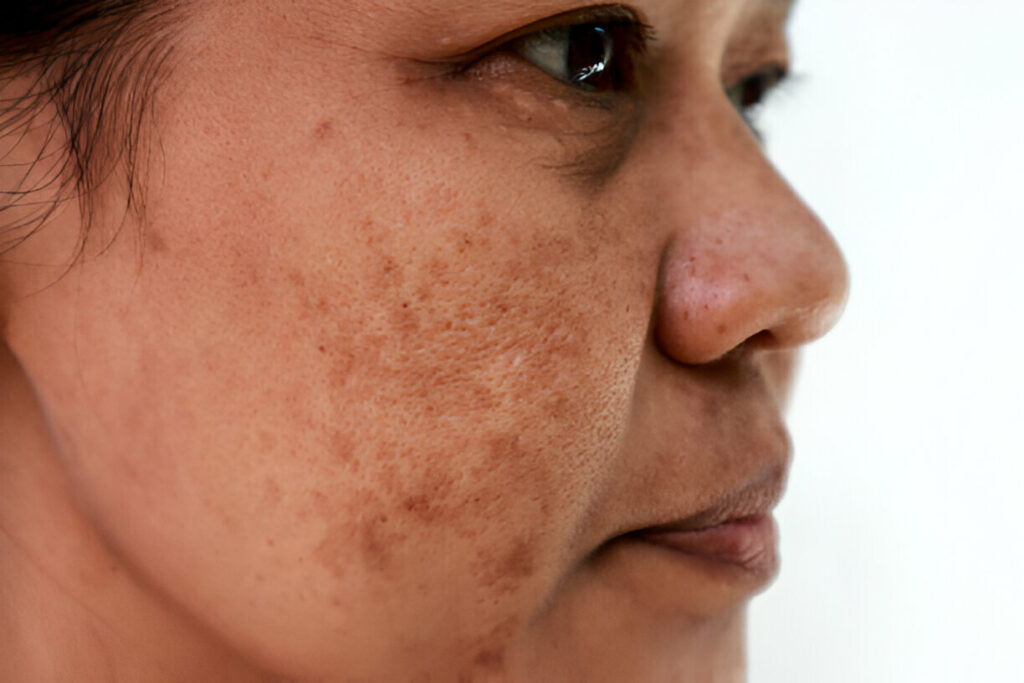Melasma is referred to as the “mask of pregnancy” since it is mostly brought on by the hormonal changes that occur during pregnancy and the use of hormonal drugs, such as birth control pills, which produce an excessive production of skin pigment. Another significant factor in melasma development is sun exposure. The good news is that melasma has multiple safe and efficient treatments available.
What Is Melasma?
Face patches that are brown or grayish-brown in color are often caused by a skin disorder called melasma. Its frequency varies based on the population, from 1.5% to 33%. Individuals with darker skin tones are more likely to develop melasma, with light brown complexion types having the highest incidence.
Melasma may go away on its own in specific circumstances. When melasma triggers disappear, this happens frequently. In some situations, it might last for a lifetime or even several years. Although short-term melasma therapies, like creams, can eradicate the illness, melasma frequently returns, particularly in the absence of adequate sun protection.
Symptoms of Melasma
On the face, melasma typically appears in the cheek, nose, chin, forehead, and upper lip.
Melasma on other body areas, like the neck, arms, or jawline, might occur occasionally. Melasma is neither unpleasant or itchy, in contrast to certain other skin disorders.
Melasma symptoms could include the following:
- Usually, melasma areas are darker than your skin tone.
- Spots may develop on the cheeks and forehead.
- Many facial features can be affected by melasma.
- Certain parts of the face may show melasma more than others.
- The longer you remain in the sun, the more obvious melasma is.
Can melasma be treated?
Although there isn’t a cure for melasma at the moment, there are a number of treatments and drugs that can help control the illness. It’s crucial to understand that various treatment choices could provide an incomplete response, in which certain discolorations lighten or go away but others stay the same. Relapses that occur frequently are also typical.
It’s crucial to be aware of any potential negative effects of the medication, such as increased skin whitening in the treated area or skin darkening brought on by inflammation. A dermatologist’s supervision while using the right drugs can help patients meet their treatment objectives and keep them met with fewer relapses.
8 Ways to Treat Melasma
There are several expert-backed treatments for melasma. They include sun protection, hydroquinone, tretinoin and a mild corticosteroid, triple combination cream, chemical peels, microneedling, platelet-rich plasma and tranexamic acid.
- Sun Protection
Using sun protection is crucial while managing melasma. Even with successful oral and topical melasma treatments, a few minutes in the sun might destroy all of your hard work.
- Hydroquinone
For many years, chemical bleaching agents like hydroquinone have been utilized. It functions by inhibiting the tyrosinase enzyme. Melasma spots can be lessened and the amount of pigment in the skin can be decreased by inhibiting this enzyme, which stops the pigment manufacturing process.
- Tretinoin and a Mild Corticosteroid
The use of a moderate topical corticosteroid—an anti-inflammatory drug that decreases inflammation and increases cell turnover—in conjunction with tretinoin, a retinoid medicine made from vitamin A. Tretinoin increases the turnover of skin cells and inhibits the metabolic process responsible for producing melanin, which leads to the loss of pigment.
- Triple Combination Cream
A single prescription cream may occasionally contain multiple bleaching agents, such as tranexamic acid, kojic acid (a naturally occurring metabolite produced by fungi that has been demonstrated to suppress the development of melanin), and hydroquinone. She says that by doing this, the bleaching benefits are maximized and the chance of skin irritation is decreased by using a lesser concentration of hydroquinone.
- Tranexamic Acid
This treatment stops melanin from being produced and from being transferred to keratinocytes, which are the skin cells that hold onto pigmentation. Oral tranexamic acid can help prevent melasma and leave the complexion looking even when combined with topical medications such as a triple combination cream that contains hydroquinone, tretinoin, and fluocinolone acetonide.
- Chemical Peels
Chemical peels are skin-resurfacing procedures that minimize the visibility of wrinkles, fine lines, pigmentation, and sun damage. According to her explanation, peels function as an exfoliator, removing the outer layers of dead, discolored skin to reveal fresh, healthy skin.
- Microneedling
Another alternative for treating melasma is microneedling, a less invasive procedure that includes superficial skin punctures with tiny fine needles. Through the creation of channels, this treatment method deepens the penetration of pigment-fighting chemicals into the skin.
- Platelet-Rich Plasma
An individual’s own blood is used to create platelet-rich plasma, a rejuvenating treatment that gives the skin access to the body’s natural growth factors. After the microneedling device has passed over the skin, the platelet-rich plasma is applied, allowing it to penetrate into the skin immediately.
It is not unsafe for melasma to progress into more serious skin conditions like skin cancer. To rule out these ailments, it’s crucial to see a dermatologist because melasma can sometimes have an appearance similar to certain skin malignancies or illnesses.
Each person will experience a different duration of treatment, which is determined by the etiology of melasma, the degree of exposure to melasma triggers (such as sun exposure), the intensity of the pigmentation, and the skin’s reaction to treatment.
Why Choose Gangnam Theme Dermatology
This article gave us a closer look about Melasma. It is a type of hyperpigmentation that appears on the face in the form of dark or gray macules or patches. It is not a serious health condition, but rather an aesthetic concern that might cause emotional anguish.
To avoid worsening your melasma, you must take some preventive steps and adhere to your dermatologist’s treatment and management guidance. Furthermore, you must ensure that you are receiving the appropriate therapy for your disease by contacting our dermatologist at Theme Dermatology Clinic, who will confirm the diagnosis.
With three board-certified dermatologists with extensive expertise, Gangnam Theme Dermatology is one of the oldest dermatology practices in Gangnam, Seoul, South Korea. It can be found right between Sinnonhyeon and Gangnam Stations, in the center of the famous Gangnam neighborhood. With an extensive experience of over 20 years in dermatology, our team of specialists is highly regarded for their expertise and unwavering commitment to excellence. Over more than 20 years, the clinic cared for patients with various skin issues and types. They can assist you with acne, pigmentation, anti-aging (lifting), scars, and other skin issues. Also, among Korean clients, they are one of the most well-known skin clinics. The variety of services they offer and their knowledge of skin issues will satisfy you.
Gangnam Theme Dermatology Booking Information
The clinic can be found at 423 Gangnam-daero, Seocho-gu, Hanseung Building, 7th Floor, Seoul, South Korea. To reach out directly, dial +821094839974 on WhatsApp and Kakao. Sending a message to Gangnam Theme Dermatology will allow you to talk about your concerns, make an appointment, or receive an online consultation. Send an email to [email protected]. You can also look through everything and ask questions on the Gangnam Theme Dermatology website by clicking this link: https://themedermatology.com/about-us/.


FAQs
Skin-lightening topicals containing hydroquinone, niacinamide, azelaic acid, kojic acid, cysteamine, tranexamic acid, and rucinol, as well as chemical peels, microdermabrasion, and laser therapy, are among the most commonly prescribed treatments by dermatologists for melasma eradication. To determine the melasma treatment option you will receive from a dermatologist.
Melasma can be induced by either internal or external sources. The main reasons are excessive skin exposure to UV or infrared radiation from the sun, as well as hormones. Melasma has been linked to elevated levels of estrogen, progesterone, and melanocyte-stimulating hormones. Melasma can also be caused by a family history or inherited traits.
According to certain studies, Vitamin B12 insufficiency can produce melasma on the face. This vitamin deficit is thought to limit the intracellular reduction potential, resulting in the oxidation of reduced glutathione and a decrease in the GSH/GSSG ratio. This further induces epidermal melanocytes to create more melanin.
Conclusion
Melasma is not a deadly or even serious disorder. Researchers discovered no malignant cases of melasma. In fact, some research suggests that melasma may reduce the chance of melanoma, a serious kind of skin cancer. Keep in mind that it may take time for melasma to fade after discontinuing hormone medications or giving delivery. Furthermore, if you resume taking those medications or become pregnant, your melasma may reappear. Overall, limiting sun exposure is one of the most effective approaches to reduce melasma. According to research, avoiding the sun’s UV radiation can help lessen the appearance and recurrence of melasma.

